Abstract
1 The non-steroid anti-inflammatory drugs, indomethacin, flufenamate and meclofenamate, inhibited the release of histamine from rat peritoneal mast cells induced by pharmacological or immunological challenge in vitro. 2 Anti-inflammatory steroids had little effect on histamine release from the mast cells. 3 Th inhibition of histamine release by the aspirin-like drugs was not prevented by incubation with glucose, unlike the inhibition of 2,4,dinitrophenol or antimycin-A. This suggests that the non-steroid anti-inflammatory compounds do not act by preventing the energy production from oxidative metabolism, required for histamine release. 4 The inhibition of the calcium ionophore A23187-induced histamine release by the aspirin-like drugs was reversed by an increase in the calcium concentration of the incubation medium. 5 The results suggest that the non-steroid anti-inflammatory compounds inhibit histamine release by actions on calcium influx into the mast cell, or on calcium mobilization or utilization within the mast cell.
Full text
PDF
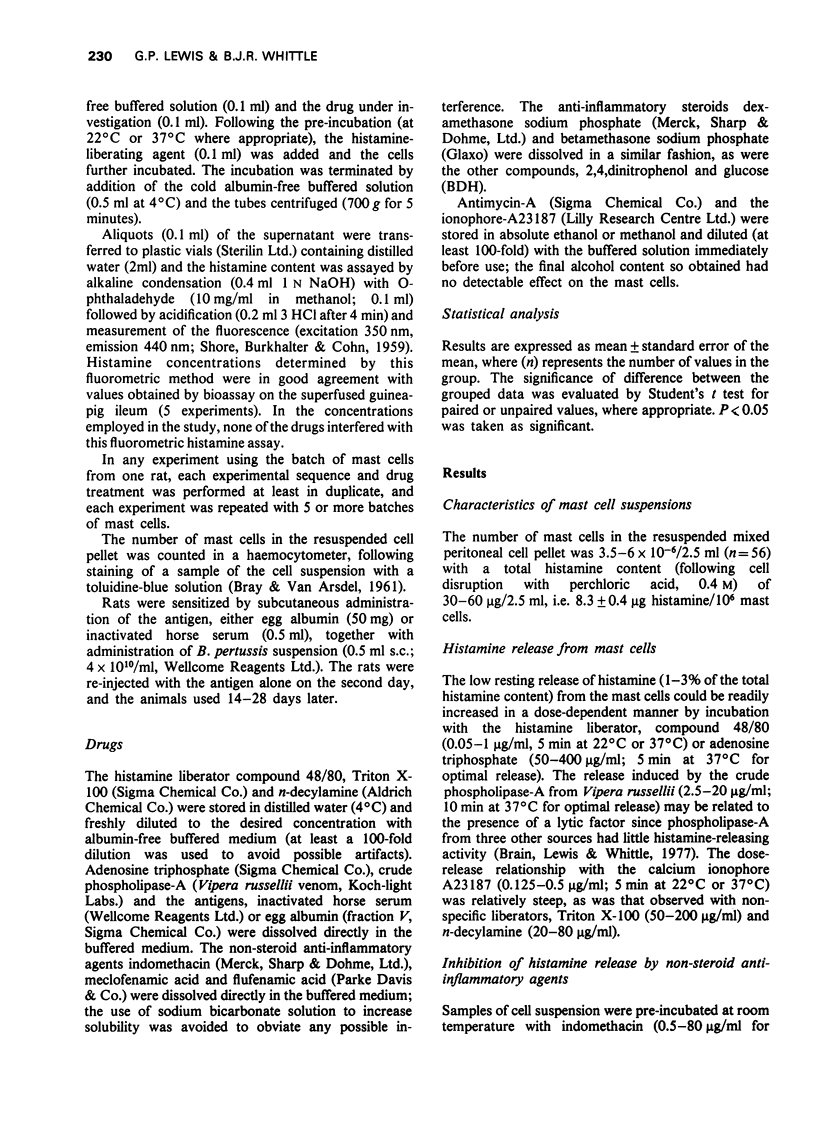
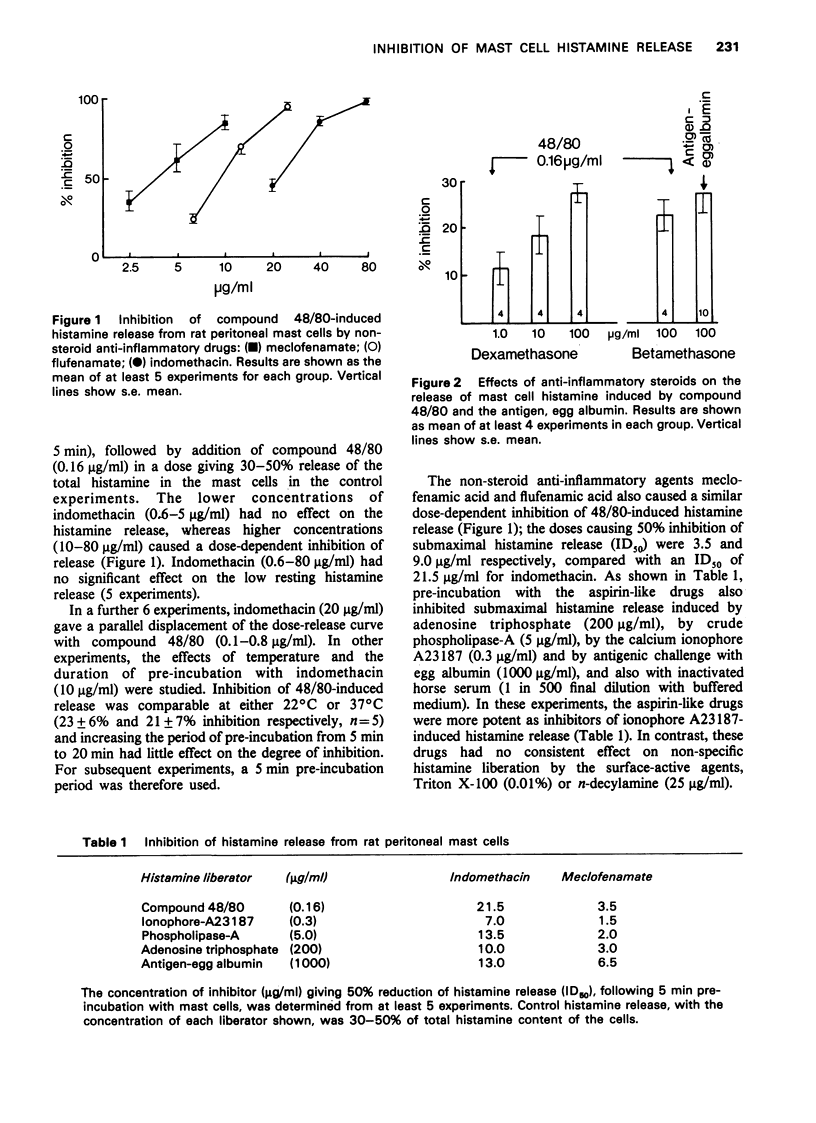
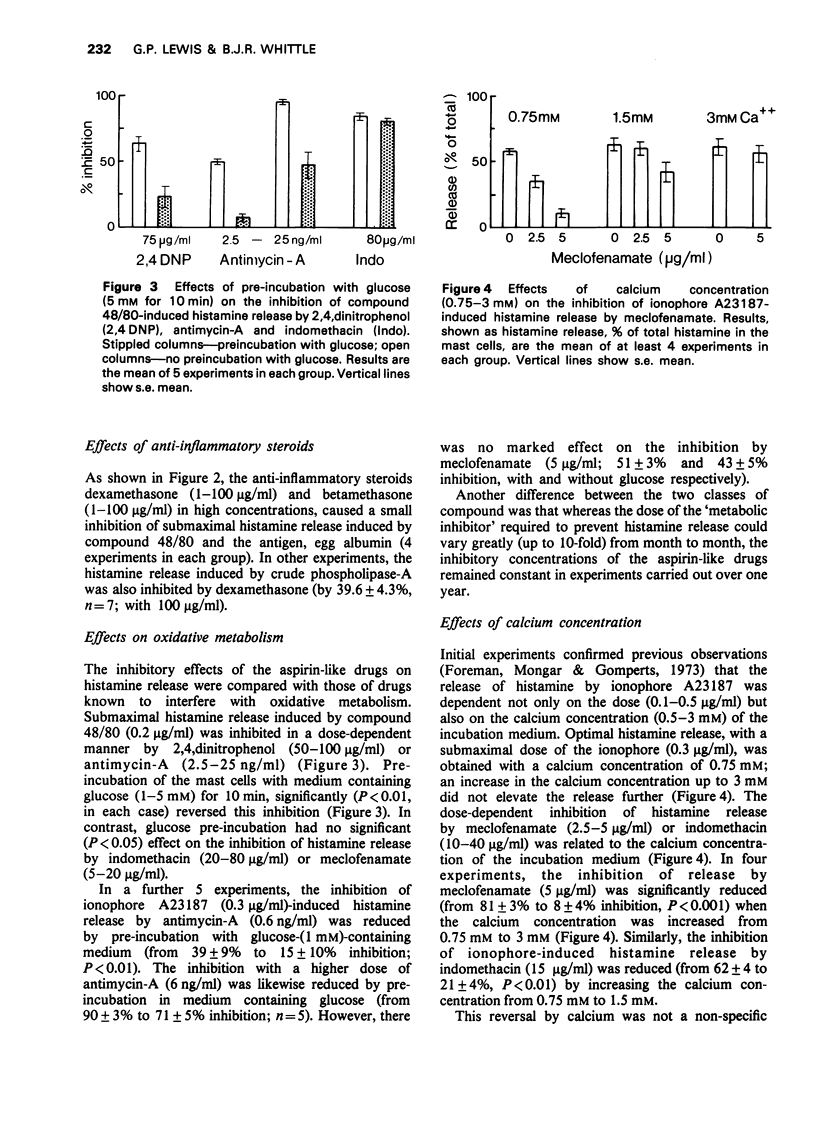
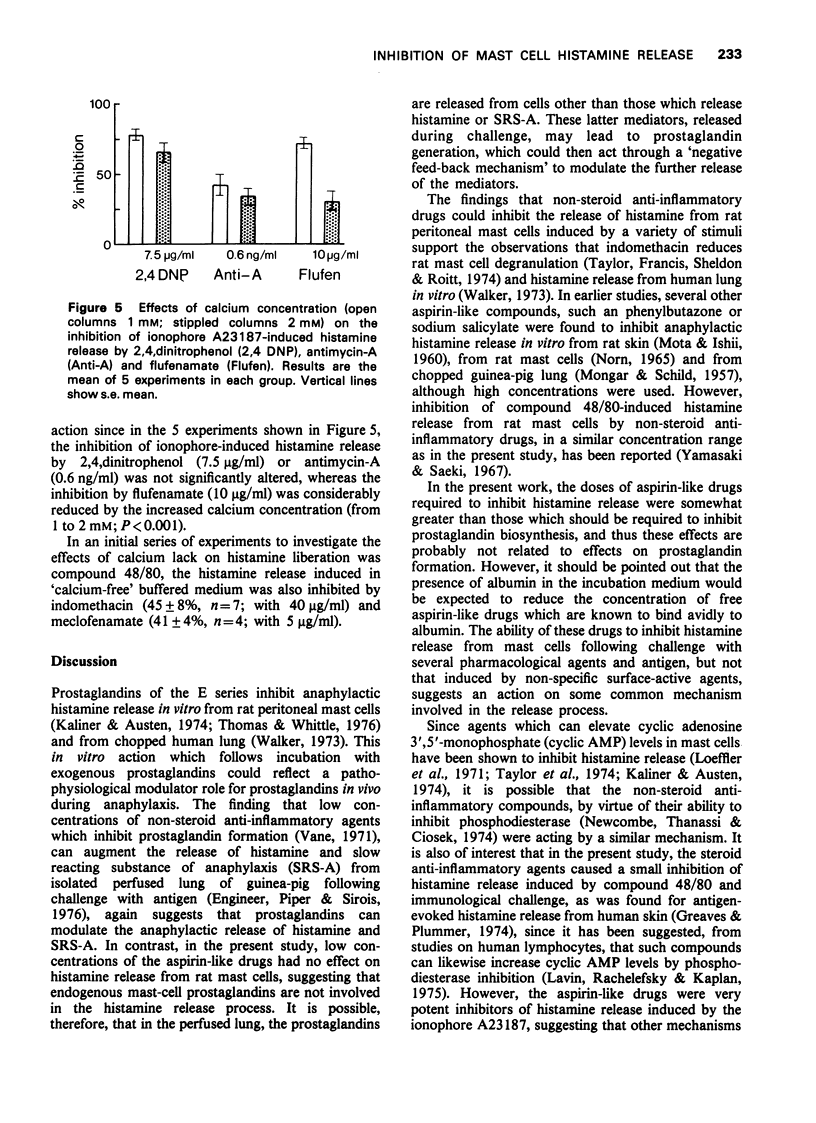
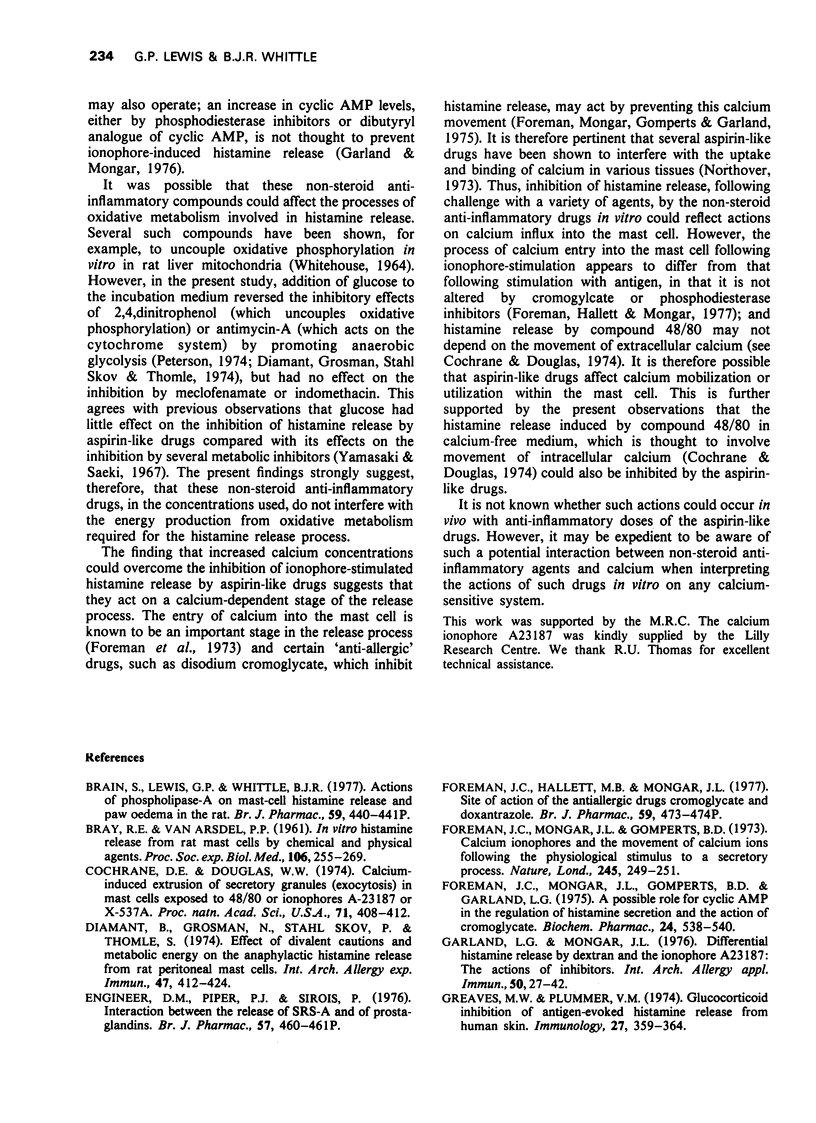
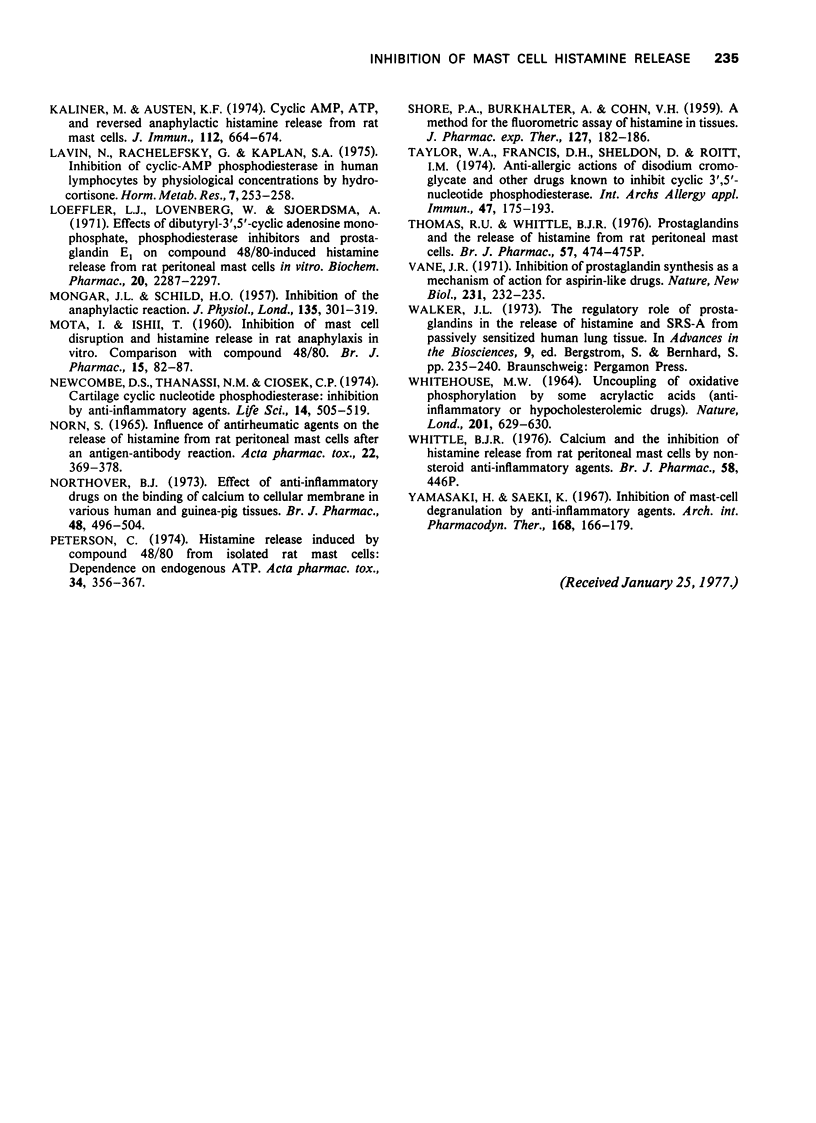
Selected References
These references are in PubMed. This may not be the complete list of references from this article.
- Brain S., Lewis G. P., Whittle B. J. Actions of phospholipase-A on mast-cell histamine release and paw oedema in the rat [proceedings]. Br J Pharmacol. 1977 Mar;59(3):440P–441P. [PMC free article] [PubMed] [Google Scholar]
- Cochrane D. E., Douglas W. W. Calcium-induced extrusion of secretory granules (exocytosis) in mast cells exposed to 48-80 or the ionophores A-23187 and X-537A. Proc Natl Acad Sci U S A. 1974 Feb;71(2):408–412. doi: 10.1073/pnas.71.2.408. [DOI] [PMC free article] [PubMed] [Google Scholar]
- Diamant B., Grosman N., Stahl Skov P., Thomle S. Effect of divalent cations and metabolic energy on the anaphylactic histamine release from rat peritoneal mast cells. Int Arch Allergy Appl Immunol. 1974;47(3):412–424. doi: 10.1159/000231234. [DOI] [PubMed] [Google Scholar]
- Engineer D. M., Piper P. J., Sirois P. Interaction between the release of SRS-A and of prostaglandins [proceedings]. Br J Pharmacol. 1976 Jul;57(3):460P–461P. [PMC free article] [PubMed] [Google Scholar]
- Foreman J. C., Hallett M. B., Mongar J. L. Site of action of the antiallergic drugs cromoglycate and doxantrazole [proceedings]. Br J Pharmacol. 1977 Mar;59(3):473P–474P. [PMC free article] [PubMed] [Google Scholar]
- Foreman J. C., Mongar J. L., Gomperts B. D. Calcium ionophores and movement of calcium ions following the physiological stimulus to a secretory process. Nature. 1973 Oct 5;245(5423):249–251. doi: 10.1038/245249a0. [DOI] [PubMed] [Google Scholar]
- Foreman J. C., Mongar J. L., Gomperts B. D., Garland L. G. A possible role for cyclic AMP in the regulation of histamine secretion and the action of cromoglycate. Biochem Pharmacol. 1975 Feb 15;24(4):538–540. doi: 10.1016/0006-2952(75)90142-2. [DOI] [PubMed] [Google Scholar]
- Garland L. G., Mongar J. L. Differential histamine release by dextran and the ionophore A23187: the actions of inhibitors. Int Arch Allergy Appl Immunol. 1976;50(1):27–42. doi: 10.1159/000231477. [DOI] [PubMed] [Google Scholar]
- Greaves M. W., Plummer V. M. Glucocorticoid inhibition of antigen-evoked histamine release from human skin. Immunology. 1974 Sep;27(3):359–364. [PMC free article] [PubMed] [Google Scholar]
- Kaliner M., Austen K. F. Cyclic AMP, ATP, and reversed anaphylactic histamine release from rat mast cells. J Immunol. 1974 Feb;112(2):664–674. [PubMed] [Google Scholar]
- Loeffler L. J., Lovenberg W., Sjoerdsma A. Effects of dibutyryl-3',5'-cyclic adenosine monophosphage, phosphodiesterase inhibitors and prostaglandin E1 on compound 48-80-induced histamine release from rat peritoneal mast cells in vitro. Biochem Pharmacol. 1971 Sep;20(9):2287–2297. doi: 10.1016/0006-2952(71)90228-0. [DOI] [PubMed] [Google Scholar]
- MONGAR J. L., SCHILD H. O. Inhibition of the anaphylactic reaction. J Physiol. 1957 Feb 15;135(2):301–319. doi: 10.1113/jphysiol.1957.sp005712. [DOI] [PMC free article] [PubMed] [Google Scholar]
- MOTA I., ISHIT T. Inhibition of mast cell disruption and histamine release in rat anaphylaxis in vitro. Comparison with compound 48/80. Br J Pharmacol Chemother. 1960 Mar;15:82–87. doi: 10.1111/j.1476-5381.1960.tb01213.x. [DOI] [PMC free article] [PubMed] [Google Scholar]
- Newcombe D. S., Thanassi N. M., Ciosek C. P., Jr Cartilage cyclic nucleotide phosphodiesterase: inhibition by anti-inflammatory agents. Life Sci. 1974 Feb 1;14(3):505–519. doi: 10.1016/0024-3205(74)90365-8. [DOI] [PubMed] [Google Scholar]
- Norn S. Influence of antirheumatic agents on the release of histamine from rat peritoneal mast cells after an antigen-antibody reaction. Acta Pharmacol Toxicol (Copenh) 1965;22(4):369–378. doi: 10.1111/j.1600-0773.1965.tb01832.x. [DOI] [PubMed] [Google Scholar]
- Northover B. J. Effect of anti-inflammatory drugs on the binding of calcium to cellular membranes in various human and guinea-pig tissues. Br J Pharmacol. 1973 Jul;48(3):496–504. doi: 10.1111/j.1476-5381.1973.tb08356.x. [DOI] [PMC free article] [PubMed] [Google Scholar]
- Peterson C. Histamine release induced by compound 48-80 from isolated rat cells: dependence on endogenous ATP. Acta Pharmacol Toxicol (Copenh) 1974 May;34(5):356–367. doi: 10.1111/j.1600-0773.1974.tb03532.x. [DOI] [PubMed] [Google Scholar]
- SHORE P. A., BURKHALTER A., COHN V. H., Jr A method for the fluorometric assay of histamine in tissues. J Pharmacol Exp Ther. 1959 Nov;127:182–186. [PubMed] [Google Scholar]
- Taylor W. A., Francis D. H., Sheldon D., Roitt I. M. Anti-allergic actions of disodium cromoglycate and other drugs known to inhibit cyclic 3',5'-nucleotide phosphodiesterase. Int Arch Allergy Appl Immunol. 1974;47(2):175–193. doi: 10.1159/000231212. [DOI] [PubMed] [Google Scholar]
- Vane J. R. Inhibition of prostaglandin synthesis as a mechanism of action for aspirin-like drugs. Nat New Biol. 1971 Jun 23;231(25):232–235. doi: 10.1038/newbio231232a0. [DOI] [PubMed] [Google Scholar]
- WHITEHOUSE M. W. UNCOUPLING OF OXIDATIVE PHOSPHORYLATION BY SOME ARYLACETIC ACIDS (ANTI-INFLAMMATORY OR HYPERCHOLESTEROLEMIC DRUGS). Nature. 1964 Feb 8;201:629–630. doi: 10.1038/201629a0. [DOI] [PubMed] [Google Scholar]
- Whittle B. J. Calcium and the inhibition of histamine release from rat peritoneal mast cells by non-steroid anti-inflammatory agents [proceedings]. Br J Pharmacol. 1976 Nov;58(3):446P–446P. [PMC free article] [PubMed] [Google Scholar]
- Yamasaki H., Saeki K. Inhibition of mast-cell degranulation by anti-inflammatory agents. Arch Int Pharmacodyn Ther. 1967 Jul;168(1):166–179. [PubMed] [Google Scholar]


